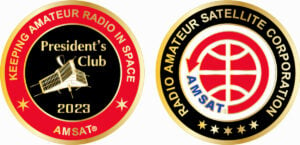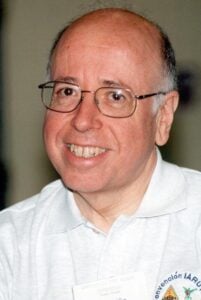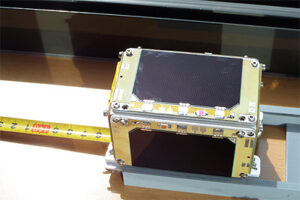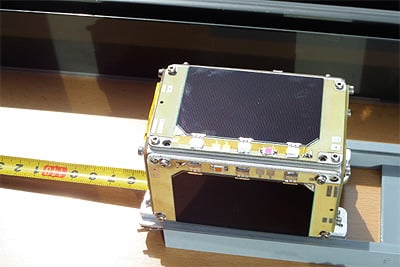In this edition:
* W2RS Memorial AMSAT CW Activity Day to be Held January 1st
* Amateur Satellites to be Featured at Ham Radio University
* Six US Schools Moved Forward in ARISS Selection Process
* Only Two Days Left to Get 2023 AMSAT President’s Club Coins
* Student-Led ARISS Contact a Success
* Changes to AMSAT-NA TLE Distribution for December 29, 2023
* ARISS News
* Upcoming Satellite Operations
* Hamfests, Conventions, Maker Faires, and Other Events
* Satellite Shorts From All Over
The AMSAT News Service bulletins are a free, weekly news and information service of AMSAT, the Radio Amateur Satellite Corporation. ANS publishes news related to Amateur Radio in Space including reports on the activities of a worldwide group of Amateur Radio operators who share an active interest in designing, building, launching and communicating through analog and digital Amateur Radio satellites.
The news feed on http://www.amsat.org publishes news of Amateur Radio in Space as soon as our volunteers can post it.
Please send any amateur satellite news or reports to: ans-editor [at] amsat [dot] org.
You can sign up for free e-mail delivery of the AMSAT News Service Bulletins via the ANS List; to join this list see: https://mailman.amsat.org/postorius/lists/ans.amsat.org/
ANS-365 AMSAT News Service Weekly Bulletins
To: All RADIO AMATEURS
From: Radio Amateur Satellite Corporation
712 H Street NE, Suite 1653
Washington, DC 20002
DATE 2023 DEC 31
W2RS Memorial AMSAT CW Activity Day to be Held January 1st
In March 2022, the AMSAT community lost one of our pioneers when Ray Soifer, W2RS, became a silent key. In addition to his numerous contributions to AMSAT and the worldwide amateur satellite community, Ray was also the long time organizer of AMSAT’s CW Activity Day – previously AMSAT Straight Key Night – held in conjunction with the ARRL’s event on New Year’s Day. In recognition of Ray’s long time service to AMSAT and his keen interest in CW operating via satellite, AMSAT’s CW Activity Day is now known as the W2RS Memorial AMSAT CW Activity Day.
The rules are simple – operate CW through any amateur satellite between 0000 UTC and 2359 UTC on January 1, 2024. Straight keys and bugs are encouraged, but not required. Logs are not required, but operators are encouraged to submit a report of their activity to the AMSAT-BB. Photos and video clips of activity are also encouraged – post them on X or other social media networks and tag @AMSAT or #amsat.
Remember to use the minimum power required for communication as constant carrier modes, including CW, can disrupt transponder operation for other users.
[ANS thanks AMSAT for the above information.]
Amateur Satellites to be Featured at Ham Radio University
AMSAT Member Peter Portanova, W2JV, will present an Amateur Radio Satellite forum- “Orbiting the Earth” – A beginners guide to operating the FM Satellites at the upcoming Ham Radio University. The Ham Radio University (HRU) educational conference will be a live event only with over 20 forums, held on Saturday, January 6, 2024 from 9:00 AM EST to 4:00 PM EST at the Hillwood Commons Student Center on the campus of LIU Post college, 720 Northern Boulevard, Brookville, NY 11548. Now in its 25th consecutive year, Ham Radio University is free to attend and no preregistration is necessary. Complete information on HRU can be found at https://hamradiouniversity.org/.
[ANS thanks Peter Portanova, W2JV, for the above information.]
Six US Schools Moved Forward in ARISS Selection Process
Amateur Radio on the International Space Station (ARISS) announced the schools/host organizations selected for the July-December 2024 window. A total of 6 of the submitted proposals during the recent proposal window have been accepted to move forward in the processes of planning to host a scheduled amateur radio contact with crew on the ISS. The primary goal of the ARISS program is to engage young people in Science, Technology, Engineering, Arts and Math (STEAM) activities and raise their awareness of space communications, radio communications, space exploration, and related areas of study and career possibilities.
The schools and host organizations are:
– Coastal Community School
Satellite Beach, FL
– Computer Museum of America
Roswell, GA
– Kopernik Observatory
Vestal, NY
– Immaculate Heart of Mary School
Wayne, NJ
– Magnet Innovation Center
Inlet Beach, FL
– Midlands STEM Charter School
Winnsboro, SC
The ARISS program anticipates that NASA will be able to provide scheduling opportunities for the 6 US host organizations during the July-December 2024 time period. They are now at work completing an acceptable equipment plan that demonstrates their ability to execute the ham radio contact. Once their equipment plan is approved by ARISS, the final selected schools/organizations will be scheduled as their availability and flexibility match up with the scheduling opportunities offered by NASA.
[ANS thanks Dave Jordan, AA4KN, ARISS PR for the above information.]
Only Two Days Left to Get 2023 AMSAT President’s Club Coins
Thanks to the generosity of AMSAT members, the 2023 President’s Club has raised over $49,000 to help Keep Amateur Radio in Space! And there are still two days to go! Membership levels begin at $120. All 2023 contributors receive a full-color certificate, AMSAT logo cork beverage coasters and, of course, the stunning membership coin. To commemorate the 40th anniversary of its launch on June 16, 1983, this year’s coin features an image of AMSAT-OSCAR 10. Complete information on the AMSAT President’s Club can be found at https://www.amsat.org/join-the-amsat-presidents-club/.

But, hurry – there is only a handful of 2023 coins left and they will no longer be available once the new year begins. Become at member today at the AMSAT Store https://www.amsat.org/shop/.
[ANS thanks AMSAT for the above information.]
+=+=+=+=+=+=+=+=+=+=+=+=+=+=+=+=+=+=+=+=+=+=+=+=+=+=+=+=+=+=+=+=+=+
Need new satellite antennas? Purchase M2 LEO-Packs from the
AMSAT Store. When you purchase through
AMSAT, a portion of the proceeds goes towards
Keeping Amateur Radio in Space.
https://amsat.org/product-category/hardware/
+=+=+=+=+=+=+=+=+=+=+=+=+=+=+=+=+=+=+=+=+=+=+=+=+=+=+=+=+=+=+=+=+=+
Student-Led ARISS Contact a Success
A student-led contact with astronauts through the Amateur Radio on the International Space Station (ARISS) program was a great success that earned significant media attention. On Monday, December 11, students at Harbor Creek High School in Harborcreek, Pennsylvania, used amateur radio to talk with Astronaut Andreas Mogensen, KG5GCZ.
The students are part of the Advanced Technologies Group, KC3SGV, an after-school club at Harbor Creek. Fifteen of the students are licensed radio amateurs. As ARRL News reported last week, their faculty advisor, Assistant Principal Drew Mortensen, AC3DS, is a graduate of the ARRL Teachers Institute on Wireless Technology. He utilized what he learned in the program and brought it back to the school. The ARISS contact is just one of the many successes the program has had.
ARRL Education and Learning Manager Steve Goodgame, K5ATA, was on hand for the contact, and he was impressed by the skills demonstrated by the students.
Goodgame recalled, “From antenna assembly and installation to the actual control operator function of the radio during the contact itself, students were at the helm. Every student who asked a question of Commander Mogensen was a licensed amateur radio operator. When I asked what they had planned next, the response was, ‘Well, the logical step would be to build and get a CubeSat launched.’ This is exactly the type of program we hope to help create as an outcome of the Teachers Institute,” said Goodgame.
Local, regional, and national media took note of the students’ success. Local television newscasts (see Amateur Radio in the News below) featured the event, and NBC Journalist Harry Smith and a crew from NBC’s TODAY were at the event to tell the story about the young hams.
This type of exposure for amateur radio is key to growing the hobby, according to ARRL Public Relations and Outreach Manager Sierra Harrop, W5DX. “The passion of these teenage operators led to this success story. Who doesn’t love the story of young minds doing extraordinary things in STEM through amateur radio?” she exclaimed. ARRL Director of Development Kevin Beal, K8EAL, mentioned that the media coverage demonstrates the impact that the donors who have funded the Teachers Institute have on the future of amateur radio. Beal said, “The reach goes far beyond the one-week training institute and ripples out farther than we can see.”
The ARRL Teachers Institute on Wireless Technology is funded by the ARRL Education and Technology Fund. If you are interested in supporting STEM education through the Teachers Institute on Wireless Technology, visit https://www.arrl.org/GiveToSTEM.
[ANS thanks ARRL News for the above information.]
Changes to AMSAT-NA TLE Distribution for December 29, 2023
Two Line Elements or TLEs, often referred to as Keplerian elements or keps in the amateur community, are the inputs to the SGP4 standard mathematical model of spacecraft orbits used by most amateur tracking programs. Weekly updates are completely adequate for most amateur satellites. Elements in the TLE bulletin files are updated daily. TLE bulletin files are updated to add or remove satellites as necessary Thursday evenings around 2300 UTC, or more frequently if new high interest satellites are launched. More information may be found at https://www.amsat.org/keplerian-elements-resources/
HADES-D has been renamed Spain-OSCAR 121
[ANS thanks Joe Fitzgerald, KM1P, AMSAT Orbital Elements Manager for the above information.]
ARISS NEWS
Upcoming Contacts
No contacts have been scheduled from December 21, 2023 to January 14, 2024.
[ANS thanks Charlie Sufana, AJ9N, one of the ARISS operation team mentors for the above information.]
Upcoming Satellite Operations
No scheduled operations are listed at this time.
A growing number of satellite rovers are currently engaged in sharing their grid square activations on https://hams.at. By visiting the website, you gain easy access to comprehensive information about the operators responsible for activating specific grid squares. Additionally, you have the ability to assess the match score between yourself and a particular rover for a given pass, while also being able to identify the upcoming satellite passes that are accessible from your location.
[ANS thanks Ian Parsons, K5ZM, AMSAT Rover Page Manager, for the above information.]
Hamfests, Conventions, Maker Faires, and Other Events
AMSAT Ambassadors provide presentations, demonstrate communicating through amateur satellites, and host information tables at club meetings, hamfests, conventions, maker faires, and other events.
Ham Radio University
January 6, 2024
LIU-POST
Hillwood Commons Student Center
720 Northern Boulevard, Brookville, NY 11548
https://hamradiouniversity.org/
Satellite Shorts From All Over
+ Think a 75-minute presentation on “working the easy satellites” would be appropriate for your club or event? Send email an to Clint at k6lcsclint (at) gmail (dot) com. Already booking dates for 2024! From a club recently: “Thank you for the well-done presentation this evening. After the Zoom session had ended, my members would not go home: They just wanted to keep talking about your presentation. Again, well done and thank you.” – Phil N2EDX, VP Daytona Beach ARA [ANS thanks Clint Bradford, K6LCS, AMSAT Ambassador for the above information.]
+ The presentations from the 50th Anniversary AMSAT-DL. Anniversary Satellite Meeting on September 16, 2023 in Bochum are available on the YouTube channel at https://bit.ly/3RYfqWP. Subtitles are available and can be enabled in YouTube, with automatic translation into other languages. [ANS thanks AMSAT-DL for the above information.]
+ The 2024 CubeSat Developers Workshop, an annual conference hosted by the Cal Poly CubeSat Laboratory, will be held April 23–25, 2024. The event will be held at Cal Poly, San Luis Obispo Performing Arts Center in-person as it has in years past. The conference draws more than 500 industry professionals, small satellite developers and students who will take part in three days of live presentations, Q&A panels, exhibit booths, and more. This conference is particularly useful to new members of the CubeSat community with invaluable opportunities to meet and talk to industry veterans. If you are interested in hearing more about this year’s conference, click the link below! For more information go to https://www.cubesat.org/. [ANS thanks cubesat.org for the above information.]
+A piece of America’s space history is now on the ocean’s floor. During its return voyage to Port Canaveral in Central Florida, a SpaceX Falcon 9 first stage booster toppled over and broke in half. This particular booster, tail number B1058, was coming back from its record-breaking 19th mission when it had its fatal fall. The rocket lifted off from Cape Canaveral Space Force Station on Dec. 23 carrying 23 Starlink satellites. The booster made a successful landing eight and a half minutes after launch on the drone ship ‘Just Read the Instructions’ which was stationed east of the Bahamas. SpaceX said in a statement on social media that it succumbed to “high winds and waves.” [ANS thanks SpaceNews for the above information.]
Join AMSAT today at https://launch.amsat.org/
In addition to regular membership, AMSAT offers membership to:
* Societies (a recognized group, clubs or organization).
* Primary and secondary school students are eligible for membership at one-half the standard yearly rate.
* Post-secondary school students enrolled in at least half time status shall be eligible for the student rate for a maximum of 6 post-secondary years in this status.
* Memberships are available for annual and lifetime terms.
Contact info [at] amsat.org for additional membership information.
73 and remember to help Keep Amateur Radio in Space!
This week’s ANS Editor, Frank Karnauskas, N1UW
n1uw [at] amsat [dot] org



